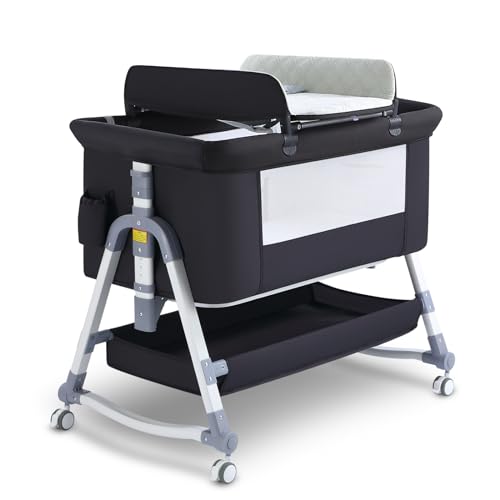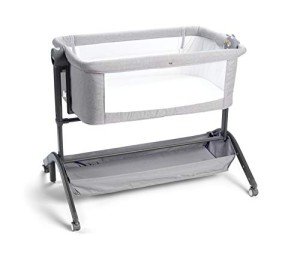Bedside Baby Bed Techniques To Simplify Your Daily Lifethe One Bedside…
페이지 정보

본문
 Bedside Baby Beds
Bedside Baby BedsBaby cribs for bedside use let parents keep their infant close during the night without compromising safety. They are made to be used by newborns from 4-6 months.
 The Halo Bassinest is a swivel-over-the-parent's-bed with a side that can be lowered to let parents pick up their infant during feeding times at night. But, the base won't fit under beds that are less than 4.5 inches high.
The Halo Bassinest is a swivel-over-the-parent's-bed with a side that can be lowered to let parents pick up their infant during feeding times at night. But, the base won't fit under beds that are less than 4.5 inches high.Safety features
A crib at bedside allows parents to monitor, soothe, and feed their babies throughout the night without having to leave their bed. This arrangement of sleeping is ideal for new mothers recovering after birth or for those with mobility issues. It can also assist parents to sleep better at night. It is nevertheless important to evaluate safety features before purchasing a bedside baby bed.
This kind of sleeping surface poses a safety concern since it doesn't offer an entirely secure barrier between the sleeping area of the parent and the infant's sleeping area. This can lead to gaps that could pose the risk of suffocation for infants. Additionally sharing a bed with a child increases the parent's body heat and increases the risk of overheating which can lead to SIDS.
Although some manufacturers claim that co-sleepers for bedside use to be safer than cribs, they aren't subject to the CPSC safety standards. They may have slats that permit a baby's legs or head to become trapped. The mechanisms for attachment could be unstable, resulting in separation.
Additionally, many of these mattresses have loose bedding that can cause suffocation. Babies lack the strength and coordination to untangle themselves from bedding that is soft. There are gaps between the frame and mattress can create a suffocation risk. Some of these products also have a hard bottom that could hurt a child when they fall on it. One commenter suggested that the CPSC include pictograms in warnings for these products. This could decrease the likelihood that caregivers miss key elements. Moreover, bedside sleepers should have an easy transition mechanism to stop the baby bedside crib from falling off the bed of their parents.
Bedding
A bedside crib (also known as a co-sleeper or bassinet) allows infants to sleep next to their parents' beds while still occupying a separate space. This method of sleeping in a safe manner helps reduce the chance of suffocation and Sudden Infant Death Syndrome by keeping children close to their parents.
Baby bedding for a sleeper at night could include crib sheets bumpers, blankets, and stuffed animals. Make sure that any bedding you use is suitable for the bedside sleeper to avoid pockets or bulges that could obstruct the baby's breathing. Make sure that the mattress you buy for your baby's bed is firm and fits tightly without any gaps around the edges.
When selecting a bedding set, look for a set that is easy to wash and dry so that you can keep it clean when your baby is having accidents or spits up in the night. You may also want to think about a travel bedside crib bag for your bedside sleeper, to make it easy to carry it around when you go on family vacations or visit your grandparents at their homes.
When your baby outgrows the bedside sleeper, you can move him or her to a crib, or a toddler that is all on its own. When transitioning, make sure to remove the crib from the bed of the parent for several weeks or months so that your child can get used to sleeping in their own space while still feeling connected to their parents' presence. Be sure to select a crib that can fold easily for storage and transportation. Certain models can be transformed into a play yard or a deeper bassinet. This makes them a perfect option for parents with young children who are keen to travel cot bedside.
Tilt function
A bedside sleeper, sometimes referred to as a bassinet, is a bassinet that is attached to the side of a bed for adults. One side is lower than the other side to enable parents to access their infant at the end of the night. It may also have a tilt function to aid in easing reflux in infants. Some parents report that this feature helps their babies sleep better. It is important to note that a slanted or elevated, sleeping surface could encourage your baby's chin to chest position. This could result in suffocation and should be avoided.
A suitable mattress is also a key factor in choosing the crib for your child's bed. It must be flat and firm, as well as ventilated. The mattress should be similar to the size of the crib and fit snugly into the frame. A second-hand mattress can increase the risk of SIDS which is why it is recommended to purchase new crib mattresses. If possible, it is recommended to purchase mattresses designed for specific bedframes.
Some bedside cribs, like the Halo BassiNest, are designed to be placed under your bed to maximize space while bringing your child closer. Some beds are too narrow to accommodate this type of crib. The feet that are splayed out of the BassiNest make it difficult to move underneath some beds. It's also difficult to slide it under a divan bed, which could cause it rock or move out of alignment with the mattress.
Other types of bedside cribs like the Ingenuity Dream and Grow bedside cot bed Bassinet can be placed beside your mattress but are not in a position to tilt. CHOICE suggests parents use these beds with a comfortable, firm mattress. The tilting of a bassinet could cause your child to fall into a risky position, increasing their chance of dying.
Position of foot-to-foot
A bedside baby bed, also called a co-sleeper or bassinet, is a compact crib that attaches to the side of a bed for an adult. This allows parents to have access to their child at any time during the night. The beds are typically larger than the traditional cots or bassinets. Some have a lower edge, which creates a barrier between the sleeping spaces. They are constructed of sturdy materials and most have wheels that make them easier to move around the house.
Some bedside cribs have tilt functions which can assist infants with digestive issues such as colic or reflux. It is essential to use the tilt function with care and only at a small angle to prevent from suffocation. Talk to your doctor or health professional if you are unsure about using the feature.
The mattress is a further safety factor to take into account when selecting a crib for your child's bedside. To decrease the risk of SIDS, the mattress needs to be flat, firm and airy. A mattress that is too firm could cause a blocked airway in newborns, which is dangerous. A mattress that is breathable can ensure that your baby stays cool throughout the night, which could lower the risk of overheating.
It's recommended that you place your baby in their own secure sleeping space - such as a crib, cot or Moses basket. It may seem appealing to sleep in the same bed with your baby but this could cause SIDS. It is recommended to wait until your baby is old enough to go to bed independently before attempting to co-sleep. If you are able to, ensure that your bedroom is not smoke-free to ensure your child is safe from secondhand smoke. If you're living on a low income, you may be eligible for assistance with a bassinet or a crib from Plunket.
Second-hand cribs
Parents who are looking to save money could be tempted by a secondhand bassinet, crib, or cradle that they receive from a relative or friend. However, cribs are one of the main causes of nursery-product related deaths especially if they have damaged or missing parts or if they have more space between slats (which can create suffocation hazards). Older mattresses may also develop dips or other conditions that could be risky for your child. If your crib is not old enough to meet the current safety standards it could be contaminated with lead paint or contain other harmful chemicals.
Check whether the crib has been recalls on the crib. Make sure the crib was coated with water-based paint since this is safer for babies. Additionally, ensure that the mattress is sturdy and snugly fits. Babies can easily slide off mattresses that are soft as well as present a risk of suffocation.
Pay special attention to second-hand bassinets and cradles, and play yards. They should all be JPMA certified and contain no sharp parts that your child could scratch or poke themselves on. Avoid putting pillows, blankets or toys to these items which could create dangerous entrapment risks.
Children have died in cribs that were altered or played with. Most of these accidents were caused by caregivers or parents who attempted to make the cribs more functional or more attractive by incorporating or modifying things. Since 1973, crib manufacturers and the CPSC have teamed up to establish mandatory standards for cribs that are safer, and have addressed things like side heights, corner posts, mattress fit and cutouts in the end panels. In the past few years, the number of deaths attributed to cribs has dropped from 150 to 200 per year to around 50.
- 이전글Baby Bedside Co Sleeper Tools To Improve Your Everyday Lifethe Only Baby Bedside Co Sleeper Trick That Everyone Should Know 25.01.20
- 다음글9 Lessons Your Parents Teach You About Travel Bedside Crib 25.01.20
댓글목록
등록된 댓글이 없습니다.

